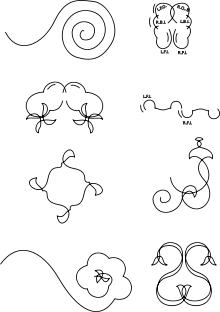Special figures were a component of figure skating in the late 19th and early 20th centuries. Like compulsory figures, special figures involved tracing patterns on the ice with the blade of one ice skate. This required the skater to display significant balance and control while skating on one foot.
While compulsory figures were standard patterns derived from the figure 8, the special figures were elaborate patterns of the skaters' own invention. These designs included rosettes, stars, crosses, and other elaborate curlicues. The building blocks for special figures included not only the elements of the standard compulsory figures, but shapes known as beaks, spectacles, and cross-cuts.
Tracing of elaborate patterns on the ice was a characteristic of the American and British schools of figure skating. By the early 20th century, this had been largely displaced by the "International Style" of free skating which utilized the entire ice surface and featured more athletic movements set to music.
Special figures was an event in the 1908 Summer Olympic Games. Nikolai Panin of Russia won the event.
See also
- Special figures by Panin
- Figure skating at the 1908 Summer Olympics
References
- The Official Book of Figure Skating. ISBN 0-684-84673-X.
- Irving Brokaw: The Art of Skating. American Sports Publishing Co., 1928.
- Benjamin Wright: Skating in America. United States Figure Skating Association, 1996.

